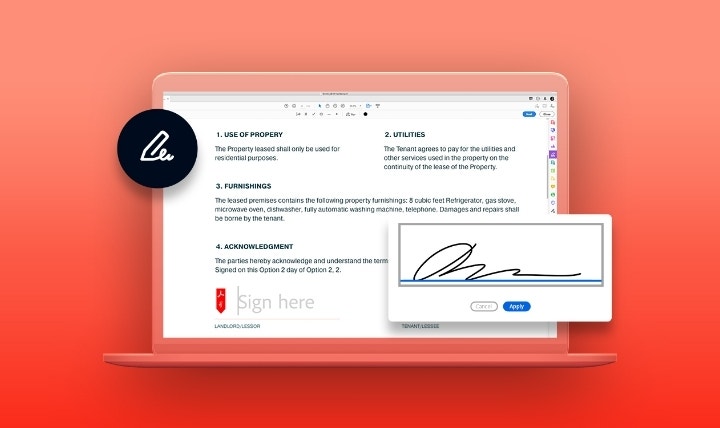Adobe Acrobat
Create an electronic residential lease agreement.
Learn when and why you need a lease agreement, what it should include, and best practices for creating an electronic rental contract that tenants can e-sign.

Residential lease agreements protect you and your tenants.
- You should create a residential lease agreement for any property you rent out.
- Every lease should outline basic rules of tenancy, including rent, payment schedule, and renewal policy.
- Digital signing software like Adobe Sign makes it easy to create, update, and sign a residential lease agreement.
Spell out the terms of the tenancy with a residential lease agreement.
A residential lease agreement lays the groundwork for a solid landlord and tenant relationship. Both parties should be able to read the contract and clearly understand the rules, responsibilities, and expectations that surround the property and its usage. Questions such as rent price and due date, repair policies, subletting rules, and late fees are all covered in a thorough rental contract.
Get leases e-signed with Adobe Acrobat Sign

Make rental agreements tenants can sign online with Acrobat Sign.
Go paperless and discover how easy it is to create, sign, and store contracts like electronic lease agreements with e-documents. With Acrobat Sign, you can quickly create a lease agreement template and add fields for signatures from future tenants. Then, send an email and collect signatures on any device. You can make changes after you send the document, and you’ll get a notification as soon as the signature comes through.
Request electronic signatures on your residential lease agreement.
Acrobat Sign makes it simple to collect signatures from your tenants, even if you’re in different states — or different time zones.
1. Open a PDF
Open your residential lease agreement in Adobe Acrobat.
2. Select Fill & Sign
It’s in the pane on the right side of the screen.
3. Add a recipient
Fill in the recipient’s email address, add an optional note, and then click Next.
4. Create your form and signature fields
Acrobat Sign will scan your document and add form and signature spaces automatically. You can also drag and drop your own fields from the pane on the right.
5. Send your form
When you click Send, each recipient will receive an email with a link to sign the document.
Why you need a residential lease agreement.
In addition to being full of handy information, a standard lease agreement is also a legal document that can be enforced in court. If a tenant fails to uphold the terms of the contract, it could be grounds for eviction. It’s important that property owners and managers don’t leave any gray areas in a lease, as they could cause issues down the road.
A residential lease agreement is needed for any residential property, whether it be a house, condo, apartment, or other living space. Different forms of real estate for rent need their own contract, such as a commercial lease agreement for a retail or office space. A residential lease agreement can also be referred to as a rental agreement, rental contract, or rental lease agreement.
The landlord, or “lessor,” draws up the written agreement, but all tenants, or “lessees,” use and benefit from it. A landlord may hire a property manager to act on their behalf, in which case this person also needs to be familiar with all the terms and conditions entailed. Tenants usually sign the lease agreement before the start of the lease term, and it remains in effect until the date agreed upon in the lease.

How to write a standard residential lease agreement.
The specifics of the lease will differ depending on whether it is an apartment lease agreement or house rental agreement. However, there are certain features every lease should include. Before you send out, be sure to consult an attorney to ensure everything is correct and in accordance with your local laws.
1. Description of the property
Outline what is and isn’t included in the rental property, such as common areas, as well as any spaces that are off-limits. Note designated parking spaces or storage areas if they’re included in the rental unit.
2. Names of the tenant(s)
Everyone listed as a tenant on the lease is responsible for upholding the terms of the residential lease agreement. Having every adult who lives on the property entered as a tenant is a form of insurance for owners, since only the parties listed in the lease can be held liable for any violations of the contract.
As the lessor, you can also require a guarantor or cosigner as an additional form of insurance if a tenant has bad credit or is too young to have established credit. This person will also be responsible for the obligations in the contract.
3. Rent payment
Outline all things payment in this all-important section of the lease. How much is the monthly rent amount? On which day of the month does the tenant need to pay rent? Are there any other monthly costs to factor in, such as pet rent or utilities? To avoid confusion, you should also include how the tenant should pay the month’s rent and list all forms of acceptable payment.
You’ll want to spell out what happens in the event of late rent payment. Note any late fees and their terms and conditions. Will there be a grace period before any late charges apply? Will a flat fee be charged or a rate that accumulates for every day the rent is unpaid?
4. Duration of the lease
There are generally two types of leases: a month-to-month lease or a fixed-term lease, which is usually for a full year or longer. Set your lease term, then note the lease termination date as well as any early termination fees, in case the tenant wants to move out before the end of the lease period.
5. Lease renewal
Include a section that outlines the terms of lease renewal: Does the tenant have the option to renew the lease or the option to purchase the property? If the landlord decides not to renew the lease for whatever reason, they will need to provide the tenant with a written notice or lease termination letter, which includes the reason for termination, the lease end date, and any final move information.
6. Security deposit
A security deposit is a sum paid to the landlord that proves the prospective tenant’s intent to move in, and can also be used in case of damage caused by the tenant. List how much the tenant should put down for the security deposit when they move in. State how the deposit will be used, if necessary, and when and how the deposit will be returned to the tenant.

7. Repair and maintenance policies
A residential lease agreement is your chance to get in writing who is (and who is not) responsible for any repairs outside of normal wear and tear. These responsibilities rarely fall on one party’s shoulders alone, so be clear about which jobs you will take on and which jobs are up to the tenant.
8. Rules and policies
To limit your liability and keep the property in good condition, you’ll want to spell out any other miscellaneous rules for your tenants. Common policies include bans on smoking, illegal activities, or pets, and requiring your tenant to have renter’s insurance. You can also establish whether sublets are allowed and outline the process of establishing a sublease agreement.
9. Disclosures
Check your local and state laws to make sure you disclose all required information to tenants. For instance, under US federal law, landlords must provide a lead paint disclosure if the property was built before 1978. It’s best practice to review the law and consult an attorney to make sure your property or lease agreement doesn’t violate rent control laws, maximum occupancy laws, and health, safety, or fire codes.
With Acrobat, when the time comes for a new lease, you won’t have to draw up a new contract every time you have new tenants. Simply resend the agreement to your renters in just one click. From rental applications to lease termination letters, manage all your leasing documents with the security and ease of e-docs.
